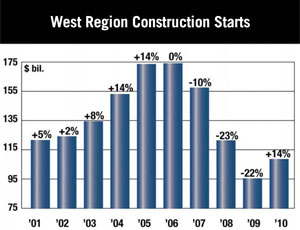...impact. Occupancies fell 57% in the first eight months of 2009 while revenue per available room dropped 18.3%, according to Smith Travel Research of Hendersonville, Tenn.. Murray expects hospitality starts to decline by 9% to $4.5 billion in 2010.


Retail has been one of the biggest casualties of the economic crisis. After hitting an all-time high of starts in 2007, Murray predicts store and shopping center work will slip 5% this year, both in the dollar value of starts and per square footage.
The one bright spot for retail is the rebound in residential building, says Ken Simonson, chief economist with Associated General Contractors of America.
“New neighborhoods being built would create demand for local retail,” he says. “It would be modest amounts. I wouldn’t expect any big shopping center construction.”
The severe drop in demand for consumer goods hit the manufacturing sector hard. Murray says that capacity utilization rates plummeted from 78.8% in December 2007 to 65.1% in June 2009, curtailing the need for new space. Murray estimates a 14% drop in 2010 to $9.4billion as capacity issues continue to hamper the sector.
Going Public Publicly funded projects represent a wild card for many analysts. Simonson says the impact of cautious consumer spending, high unemployment and a drop in home values will be fully realized as tax revenues suffer in 2010.
“State and local budgets are continuing to shrink as tax receipts fall short,” and many government agencies reduced their budget projections in the second half of 2009, Simonson says.
Education is also suffering. Murray says that K-12 construction is likely to feel the pinch of lower property taxes, and higher-education projects are challenged to find funds because endowments dropped 20% in late 2008.
McGraw-Hill Construction estimates that education buildings dropped 23% to 172 million sq ft in 2009 and expects the sector to continue its downward path in 2010 with 158 million sq ft of new starts.
While state and local governments tighten their belts, many federally funded projects are on better footing. Funding from the American Recovery & Reinvestment Act helped bolster highway construction starts in 2009. Total contracts by value for highways and bridges rose nearly $4.4 billion in 2009 to $57.3 billion.
And much of the stimulus has yet to hit the street. William R. Buechner, vice president of economics and research...



Post a comment to this article
Report Abusive Comment